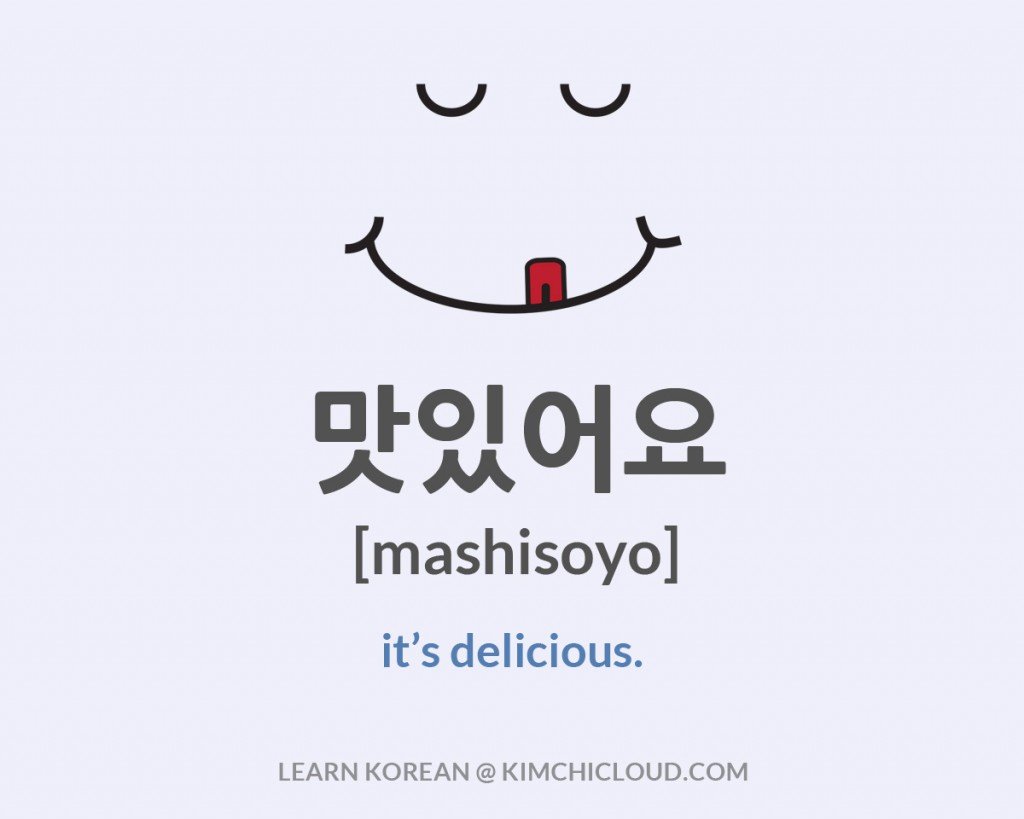맛있어요 – How to Say “Delicious” in Korean
Delicious in Korean
In this lesson, we will take a look at how to say ‘delicious’ in Korean. Food is an important part of any country or culture, and Korea is no exception. As humans, we need to eat and drink in order to survive, which makes these things arguably the most important things we do any given day. However, for most of humanity, the days where we simply ate to survive are long gone. Now our efforts tend to go into making that food as delicious and enjoyable as possible. Dining is often a social thing, and social occassions require communication, which in turn requires some kind of language. In these situations, the most useful expressions for beginners are related to taste, and more specifically if something is delicious or not. So let’s start by introducing the Korean word for ‘delicious’:
The Polite Way
mashisoyo
In Hangul: 맛있어요
This is the polite way to say “it’s delicious” in Korean, and thus, you should mainly use this form when:
- Speaking to people who are older, or have higher status (superiors, teachers etc) than you.
- Speaking to people you don’t know that well.
- You are not sure which form to use (this is always safe, and you will never risk coming off as rude).
Even though it might only seem like one word, it is actually a complete sentence. Literally, this phrase translates to “it has taste”, which, needless to say, sounds rather weird in English. Don’t be fooled, however, because it sounds perfectly natural in Korean (you see, the trick to learning Korean is to avoid the temptation of direct translation). If you want to say that something is ‘really delicious’, just add the word jinjja (진짜) in front of it! If we break this expression down part by part, we find these components:
- mas (맛) – taste
- itda (있다) – to exist, to have (dictionary form)
The words are put together to make the dictionary form mashitda (맛있다), meaning “to be delicious”. itda(있다) is then conjugated to isseoyo (있어요) which makes it proper to use in situations where you would have to show some extra respect. If you are not familiar with basic Korean grammar, don’t feel bad if this confuses you. Try instead to just focus on learning the phrase itself.
The Casual/Informal Way
mashiseo
In Hangul: 맛있어
If you’re talking to someone you are close friends with, this is the form you should use to say that something is delicious in Korean. It is the same as the expression above, but the last part yo (요) has been omitted. You should use this form primarily when talking to people younger than you, family, and people who you are really close with. Again, if you are unsure, your safest bet is to use the polite form, although Koreans are usually understanding when a foreigner gets it wrong. To reitterate, you should use this form when talking to:
- Close friends
- Family
- People younger than you.
The Formal Way
mashisseumnida
In Hangul: 맛있습니다
In case you ever find yourself eating with people where formal language is expected, mashisseumnida (맛있습니다) is the form you should use. The same words as above are involved, but with a different conjugation. Grammatically speaking, itda (있다) is conjugated to isseumnida (습니다), and then attached to the word mas (맛). You will likely not find yourself using this expression very often, and although it is always good to know, we highly suggest that you focus on the other forms. However, if you are serious about learning Korean, you will have to learn all the forms sooner or later, as you will encounter them on a daily basis.
Conclusion
This brings us to the end of this lesson on how to say ‘it’s delicious’ in Korean. To sum it up, the word you should use depends largely on the person you are talking to and the situation you are in. When in the company of someone older or of higher status then you, you should use the word mashisoyo (맛있어요). For close friends, family and people younger than you, you should use mashiseo 맛있어. Finally, for those really formal occasions, you might want to consider using mashisseumnida (맛있습니다). Also remember that the romanization of the Hangul alphabet is not always accurate (it cannot be), so if you are serious about learning Korean, you need to learn Hangul.
For more useful phrases and expressions, please check out our Everyday Korean archive. If you found this article useful, please like or share! If you have any questions or comments, please leave a comment below and we will do our best to help you out.
Bon appetit!
By: Kimchi Cloud





